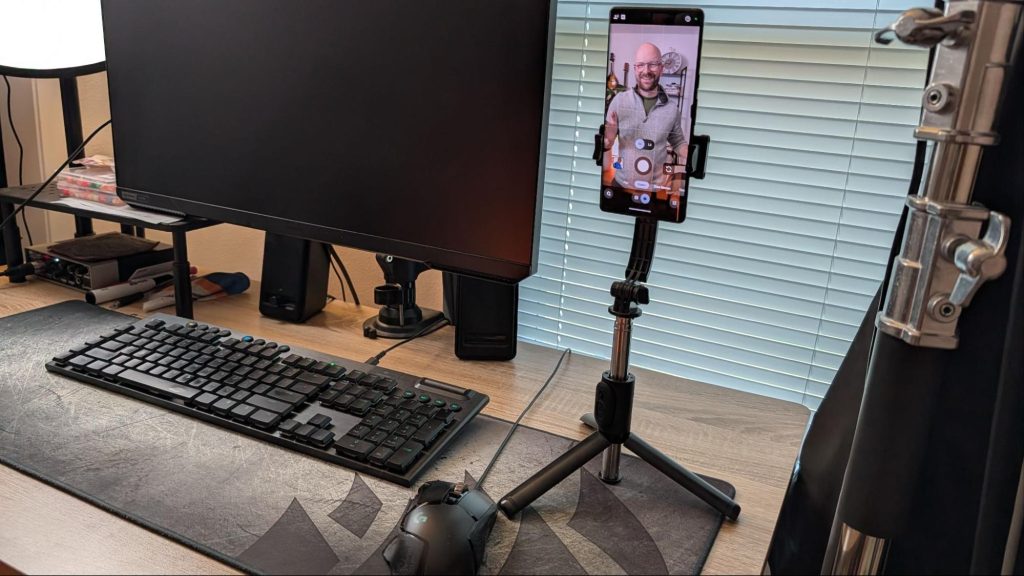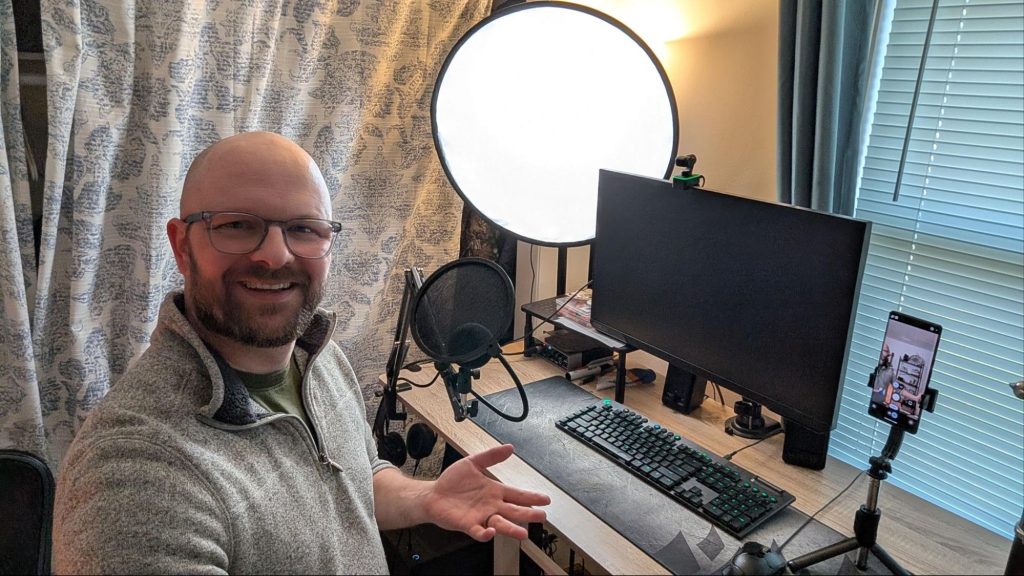Most people overcomplicate video.
They buy fancy cameras, multiple lights, expensive microphones—and all of it ends up sitting in a closet because the setup takes too long to use consistently.
The truth is much simpler: you only need one thing to start creating video for your business.
A $10 selfie stick with a phone holder.
That’s it.
It’s what most of our clients use at Dialog, and it’s what I used for years.
It removes friction and makes recording quick enough that you’ll actually do it.
If that’s enough for you, stop here. But if you want a setup that grows with your strategy, here’s a clear breakdown of what you need for both short videos and longer podcast-style videos.
This selfie stick doubles as a phone stand.
Short Videos (LinkedIn, YouTube Shorts, Website Videos)
Shortform video is everywhere—LinkedIn, TikTok, YouTube Shorts, landing pages, even gas station pumps (GSTV – the video network on gas pumps– reaches 104 million viewers every month!). While most people associate shortform with entertainment, it has quietly become one of the strongest formats for business thought leadership. Research from LinkedIn and Edelman shows that nearly half of decision-makers spend an hour or more each week consuming thought-leadership content, and video posts now earn five times more engagement on LinkedIn than other formats. With video uploads up 34% year-over-year, shortform has quietly become one of the most trusted and effective channels for business thought leadership.
And here’s the good news: for this category, you only need two tools—your phone and a $10 phone stand.
Everything else is optional. Microphones used to be a required purchase, but AI has changed that. Tools like Adobe Podcast and Riverside Magic Audio can take average audio and make it sound clean and polished, which means you don’t need a high-end mic to get started.
Lighting is the only upgrade worth considering early. Natural window light with a drawn shade gives you a soft, even result. If you want more control—especially for evening shoots—add one Neewer LED panel light and a softbox. They’re inexpensive, portable, and reliable, but most people can get by with daylight and a window.
This simple setup is all you need to film thought leadership clips, Q&A videos, quick insights, or educational content. It’s minimal, fast, and easy to use consistently.
Longer Videos and Podcasts
If you’re recording longer YouTube-style videos or want to look and sound polished on podcasts, you’ll want a few upgrades. There are four main categories to think about.
A better microphone. Most well-rated mics will do the job. I personally use the Behringer XM8500 with an XLR cable and an audio interface. Clients also use the Shure MV6 or the Yeti USB mic with great results. The important part is choosing the correct pickup pattern. If you sound distant or echoey, it’s often because the mic is listening from the wrong direction. Test your audio before you hit record.
Better lighting. Lighting is the trickiest part of video and the one thing that dramatically affects your final look. The simplest setup is two panel lights—one at 10 o’clock and one at 2 o’clock. One becomes your key light; the other becomes your fill light. Your window can also serve as a fill. Adding a softbox reduces shine, and adding a backlight (even a $30 LED strip) instantly elevates the visual feel.
My look includes a LED panel light to my left with a softbox on it and a window with blinds drawn to my right. And I have a LED light strip pointing up at the base of the wall behind me to add some variety to my background.
You can see my bright main light (also called a keylight) at the top of the photo and my window to the right, which serves as my fill light. My keylight is permanently attached to my desk via a desk mount.
LED strip light in action.
A better camera. My go-to recommendation is the Insta360 webcam. It shoots in 4K and gives you manual controls for exposure and color. One small tip: turn off the auto-tracking feature unless you want the camera following your movements.
Your background. This is the most overlooked component of video quality. A blank wall drains visual energy from your shot. Use a shelf, a plant, artwork, instruments, fluted paneling, or even the corner of your office to create depth and texture. Nothing needs to be expensive. My own background includes a shelf, two guitars, and a fig tree I found on sale at Walmart. A set-and-forget background also saves time. I walk into my office, turn on the lights, and start recording without moving anything.
Software (Keep It Simple)
We record our longform videos in Riverside and edit everything in Riverside or Adobe Premiere Pro. Editing can easily consume hours if you do it yourself, and founders typically underestimate that time cost. Even I get sucked into editing my own videos from time to time that I thought would “only take a minute.” If you can, hire an editor. It will save you time and improve your output.
The Bottom Line
Start simple. Begin with your phone and a $10 stand. Add lighting if you need more consistency. Upgrade to podcast gear only when your strategy demands it. Your setup is only as good as your ability to turn it on quickly, which is why friction-free equipment always wins.
If you’d like to see the exact equipment list I share with clients just getting started, here it is: The Friction-Free Video Equipment List from Dialog.
And if you want help setting up your space, Dialog offers a studio setup call to walk you through it live.
 Author Bio:
Author Bio:
Justin is a marketing nerd. His gateway drug was in middle school when he and his buddies would make up brand names and draw logos for fun. He graduated with a B.A. in Graphic Design from UW Eau Claire. He then cut his teeth leading the marketing for a $4 million non-profit, moving them into the digital age with new channels and systems. He joined a $60M healthcare manufacturer as marketing team of 1, helping grow them to $90M in three years. Justin became a full-time marketing entrepreneur in 2018. He now enables founders to grow their pipeline and thought leadership through thought leadership video content. Learn more at www.dialogwith.us.






 Author Bio:
Author Bio:
0 Comments